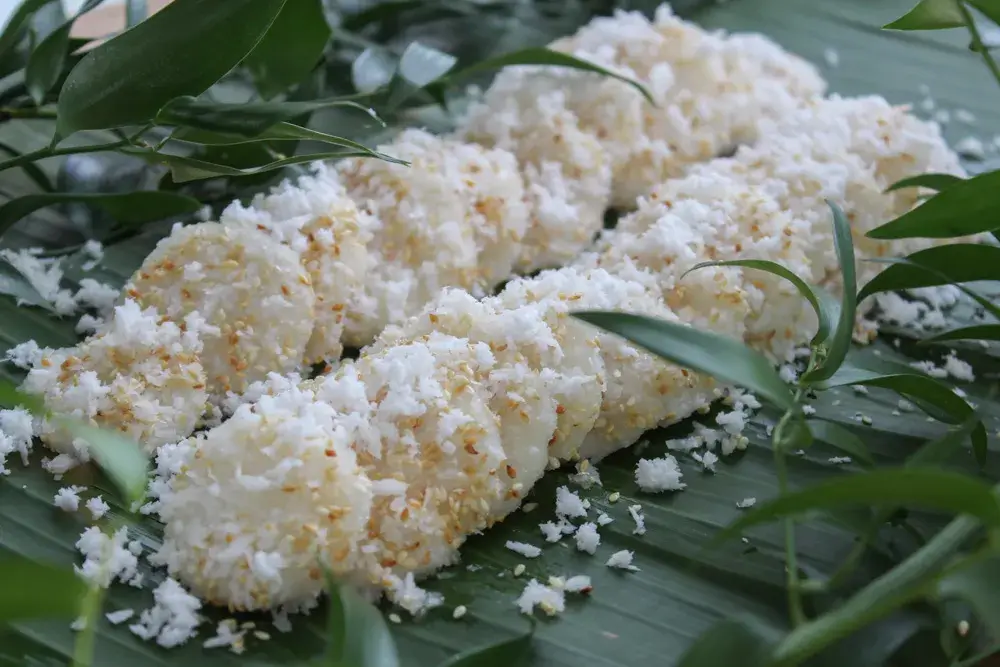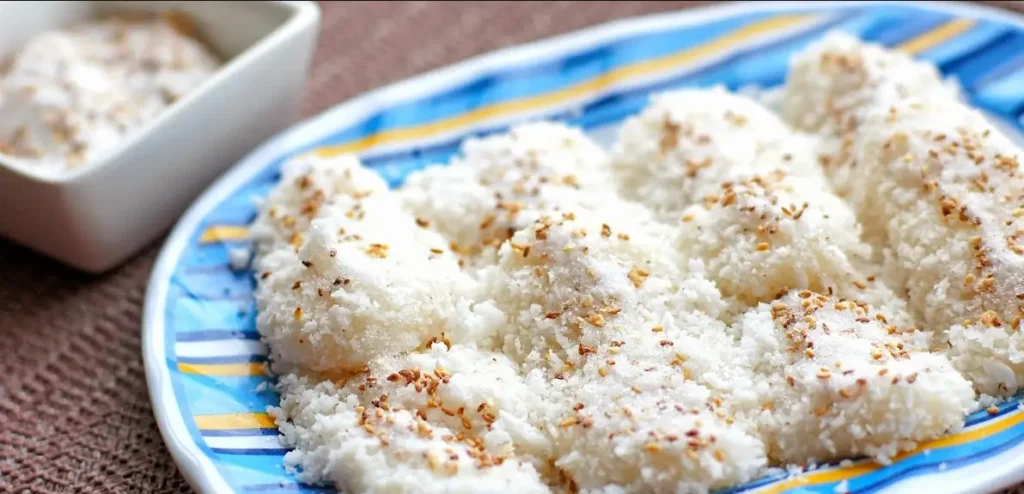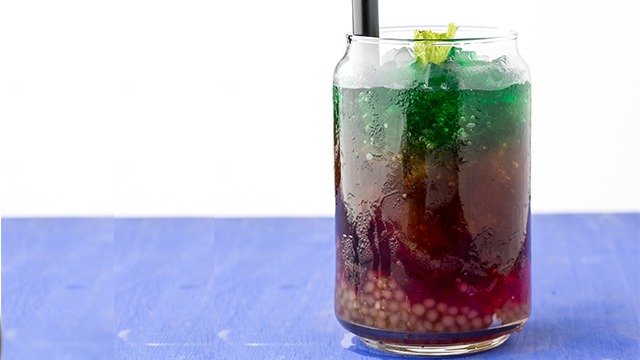Palitaw: Traditional Filipino Rice Cakes That Float to Perfection
Discover the authentic art of making Palitaw, the beloved Filipino dessert that has delighted families for generations with its simple ingredients and soul-warming flavors.
Palitaw stands as one of the Philippines’ most cherished traditional desserts, embodying the essence of Filipino comfort food in every soft, chewy bite. This delightful rice cake, whose name literally means “to float,” represents more than just a sweet treat—it’s a cultural treasure that connects generations through shared kitchen memories and time-honored techniques.
Whether you’re a Filipino longing for a taste of home or someone eager to explore authentic Asian desserts, this comprehensive guide will transform you into a Palitaw master. We’ll uncover the secrets behind achieving that perfect texture, explore regional variations, and share expert tips that ensure your Palitaw floats beautifully every single time.
What is Palitaw? Understanding the Filipino Rice Cake Phenomenon
Palitaw (pronounced “pah-lee-taw”) is a traditional Filipino kakanin—a term that encompasses all Filipino rice-based desserts and snacks. This simple yet satisfying treat consists of glutinous rice flour dough shaped into small ovals, boiled until they float to the surface, then generously coated with freshly grated coconut and a sweet sesame-sugar mixture.
The dessert’s distinctive name comes from the Tagalog word “litaw,” meaning “to float” or “to surface.” This naming convention reflects the cooking method’s visual cue: when the rice cakes bob to the water’s surface, they’re perfectly cooked and ready to be transformed into the delectable treats Filipino families have enjoyed for centuries.
What sets Palitaw apart from other rice cakes is its remarkable simplicity paired with extraordinary satisfaction. Unlike elaborate desserts requiring specialized equipment or exotic ingredients, Palitaw achieves its magic through just four basic components working in perfect harmony.
The Rich History and Cultural Significance of Palitaw
Ancient Origins in Philippine Cuisine
Palitaw’s roots trace back to the pre-colonial Philippines, originating in Pangasinan, a province in northern Luzon known for its rich rice-growing traditions. Historical evidence suggests that early Filipino communities developed this dessert as a way to transform their abundant rice harvest into portable, long-lasting treats that could be enjoyed during festivals and special occasions.
The original preparation method involved pounding freshly harvested sticky rice using traditional wooden mortars called “lusong.” This labor-intensive process created the glutinous rice flour essential for Palitaw’s characteristic texture. Families would gather during harvest season, making this dessert a communal activity that strengthened social bonds while preserving cultural traditions.
Evolution Through the Centuries
As trade routes expanded and foreign influences shaped Philippine cuisine, Palitaw adapted while maintaining its core identity. The introduction of sugar during the Spanish colonial period refined the dessert’s sweetness profile, while the arrival of sesame seeds through Chinese traders added the nutty complexity that defines modern Palitaw.
Today, Palitaw remains deeply embedded in Filipino culture, particularly during celebrations like Christmas, New Year, and town fiestas. Many Filipino families still consider homemade Palitaw a symbol of love and care, often prepared by grandmothers passing down treasured recipes to younger generations.
Essential Ingredients: Building Blocks of Perfect Palitaw
Primary Ingredients Breakdown
Glutinous Rice Flour (2 cups) The foundation of exceptional Palitaw lies in selecting premium glutinous rice flour, also known as sweet rice flour or mochiko. This specialty flour creates the dessert’s signature chewy texture and ability to hold together during boiling. Regular rice flour simply cannot achieve the same results due to its different starch composition.
Water (1 cup) Quality water plays a crucial role in dough consistency. Room temperature filtered water works best, as it allows for better flour hydration and easier mixing. The water-to-flour ratio determines whether your dough will be workable or problematically sticky.
Fresh Grated Coconut (1 cup) Nothing compares to freshly grated mature coconut for authentic Palitaw flavor. The natural oils and subtle sweetness of fresh coconut meat create layers of tropical richness that desiccated coconut simply cannot match. If fresh coconut isn’t available, high-quality unsweetened shredded coconut serves as an acceptable substitute.
Granulated Sugar (½ cup) Pure cane sugar provides the clean sweetness that balances Palitaw’s mild rice flavor. Some traditional recipes incorporate muscovado or brown sugar for deeper caramel notes, but white sugar remains the classic choice for its neutral sweetness profile.
Toasted Sesame Seeds (½ cup) Properly toasted sesame seeds contribute essential nutty depth and aromatic complexity. The toasting process intensifies their natural oils, creating the fragrant coating that makes each bite irresistible. Both black and white sesame seeds work beautifully, with black seeds offering slightly more robust flavor.
Ingredient Quality and Sourcing Tips
When shopping for ingredients, prioritize Asian grocery stores for the most authentic options. Look for glutinous rice flour brands like Mochiko or Three Ladies, which consistently deliver reliable results. Fresh coconuts should feel heavy for their size and produce a sloshing sound when shaken, indicating fresh coconut water inside.
For sesame seeds, choose raw, unhulled varieties when possible, as they toast more evenly and maintain better flavor integrity. Store unused glutinous rice flour in airtight containers away from moisture to prevent clumping and maintain freshness.
Step-by-Step Palitaw Recipe: Mastering the Traditional Technique
Preparation Phase (10 minutes)
Begin by organizing your workspace and gathering all ingredients. This mise en place approach ensures smooth cooking flow and prevents common mistakes that occur when rushing through steps.
Toast the Sesame Seeds: Heat a dry skillet over medium-low heat and add sesame seeds in a single layer. Stir frequently for 3-4 minutes until seeds turn golden brown and release their nutty aroma. Remove from heat immediately to prevent burning and allow to cool completely.
Prepare the Sugar Mixture: Combine the cooled toasted sesame seeds with granulated sugar in a shallow bowl. Mix thoroughly to ensure even distribution. This mixture serves as the final coating that gives Palitaw its signature flavor profile.
Creating the Perfect Dough (5 minutes)
Mixing Technique: In a large mixing bowl, create a well in the center of the glutinous rice flour. Gradually add water while stirring with a wooden spoon or your hands. The key to perfect dough lies in gradual water incorporation—adding too much water at once creates a sticky mess that’s difficult to correct.
Texture Assessment: The ideal Palitaw dough should feel smooth, pliable, and slightly tacky but not sticky enough to cling to your hands. If the dough feels too wet, add glutinous rice flour one tablespoon at a time. If too dry, incorporate water by the teaspoon until proper consistency develops.
Kneading Process: Once water is fully incorporated, knead the dough for 2-3 minutes until it becomes smooth and elastic. Proper kneading develops the gluten structure necessary for Palitaw’s characteristic chewy texture.
Shaping the Rice Cakes (10 minutes)
Portion Control: Divide the dough into equal portions using a tablespoon or small ice cream scoop. Each portion should weigh approximately 20-25 grams for consistent cooking times and uniform presentation.
Shaping Technique: Roll each portion between your palms to create smooth balls, then gently flatten into oval shapes about ¼-inch thick. Keep your hands slightly damp with water to prevent sticking, but avoid making them too wet, which can affect the dough’s integrity.
Professional Tip: Work with one portion at a time while keeping remaining dough covered with a damp cloth. This prevents surface drying that can cause cracking during cooking.
Cooking Process: The Floating Test (15 minutes)
Water Preparation: Fill a large, heavy-bottomed pot with water, ensuring at least 4 inches of depth. Bring to a rolling boil over high heat, then reduce to medium-high to maintain active bubbling without violent agitation.
Cooking in Batches: Add shaped Palitaw pieces to boiling water in small batches of 6-8 pieces to prevent overcrowding. Overcrowded pots cause uneven cooking and potential sticking between pieces.
The Floating Indicator: Watch carefully as Palitaw pieces sink initially, then gradually rise to the surface. Once they float and remain on top for 30 seconds, they’re perfectly cooked. This typically takes 3-5 minutes depending on thickness and water temperature.
Removal Technique: Use a slotted spoon to remove cooked Palitaw, allowing excess water to drain briefly before transferring to a clean plate. Work quickly but gently to maintain their delicate shape.
Final Assembly and Coating (5 minutes)
Coconut Coating: While Palitaw pieces are still warm, roll each one in fresh grated coconut until completely covered. The residual heat helps the coconut adhere naturally without requiring additional moisture.
Sugar-Sesame Finishing: Generously sprinkle the coconut-coated Palitaw with the prepared sesame-sugar mixture. Press gently to ensure adherence, creating the traditional three-layer coating that defines authentic Palitaw.
Professional Tips and Troubleshooting Guide
Common Mistakes and Solutions
Problem: Dough Too Sticky Solution: Add glutinous rice flour gradually, one tablespoon at a time, kneading thoroughly between additions. Avoid adding too much at once, which creates uneven texture.
Problem: Palitaw Doesn’t Float Solution: This usually indicates insufficient water depth or pieces that are too thick. Ensure water depth exceeds 4 inches and keep Palitaw thickness consistent at ¼-inch.
Problem: Uneven Cooking Solution: Maintain consistent water temperature and avoid overcrowding the pot. Cook in smaller batches for more even heat distribution.
Problem: Coconut Won’t Stick Solution: Coat Palitaw while still warm and slightly damp from cooking. Completely dry pieces won’t hold coconut effectively.
Expert Techniques for Superior Results
Temperature Control: Maintain water temperature just below a rolling boil once Palitaw is added. Excessively vigorous boiling can cause delicate pieces to break apart or cook unevenly.
Timing Precision: Set a timer when pieces begin floating to ensure consistent cooking. Overcooked Palitaw becomes mushy, while undercooked pieces maintain a raw flour taste.
Batch Consistency: Keep shaped but uncooked Palitaw covered with a damp towel to prevent surface drying. Work systematically through batches to maintain quality control.
Regional Variations and Creative Adaptations
Traditional Regional Styles
Pangasinan Style (Original) The birthplace of Palitaw maintains the purest traditional preparation, often using freshly ground rice flour and coconut palm sugar for enhanced depth and authenticity.
Tausug and Yakan Variations These southern Philippine versions incorporate coconut filling inside the rice cake, creating a more complex flavor profile and increased richness.
Visayan Adaptations Some Visayan regions add pandan extract to the dough, creating beautiful green coloring and subtle floral fragrance that complements the coconut coating.
Modern Creative Variations
Ube Palitaw Modern Filipino-American cooks often incorporate ube (purple yam) extract or powder into the dough, creating vibrant purple rice cakes that maintain traditional flavors while adding visual appeal.
Chocolate Sesame Variation Some innovative cooks replace regular sesame seeds with black sesame seeds and add cocoa powder to the sugar mixture, creating sophisticated chocolate undertones.
Coconut Milk Enhancement Replacing water with coconut milk in the dough creates richer, more decadent Palitaw with intensified coconut flavor throughout each bite.
Nutritional Profile and Health Considerations
Nutritional Breakdown (Per Serving)
A typical Palitaw serving (3 pieces) contains approximately:
- Calories: 145-160
- Carbohydrates: 31-35g
- Protein: 3-4g
- Fat: 1-2g
- Fiber: 1-2g
- Sugar: 8-12g
Health Benefits and Considerations
Positive Nutritional Aspects: Glutinous rice provides sustained energy through complex carbohydrates, while sesame seeds contribute healthy fats, protein, and essential minerals like calcium and magnesium. Fresh coconut adds medium-chain triglycerides (MCTs), which some studies suggest may support metabolism.
Dietary Considerations: Palitaw is naturally gluten-free, making it suitable for those with celiac disease or gluten sensitivity. However, its high carbohydrate and sugar content means diabetics should enjoy it in moderation as part of a balanced meal plan.
Portion Control: Traditional serving sizes range from 2-4 pieces per person, depending on whether Palitaw serves as a dessert or afternoon snack. The rich coconut and sugar coating provides satisfying sweetness in small portions.
Perfect Pairings and Serving Suggestions
Traditional Accompaniments
Filipino Coffee (Kapeng Barako) The robust, earthy flavors of traditional Filipino coffee provide an ideal counterpoint to Palitaw’s sweetness, creating a balanced afternoon merienda experience.
Hot Chocolate (Tsokolate) Rich, thick Filipino hot chocolate made from tablea (cacao tablets) complements Palitaw’s coconut flavors while adding luxurious depth to the dessert experience.
Fresh Tropical Fruits Sliced mangoes, pineapple, or banana provide acidic brightness that cuts through Palitaw’s richness while maintaining the tropical flavor theme.
Modern Presentation Ideas
Elegant Plating: Arrange Palitaw on banana leaves for authentic presentation, or use modern white plates with coconut shavings and sesame seed garnish for contemporary appeal.
Interactive Serving: Present components separately, allowing guests to customize their coating preferences. Some prefer extra coconut, while others enjoy additional sesame-sugar mixture.
Dessert Course Integration: Incorporate Palitaw into larger Filipino dessert spreads alongside buko pandan, leche flan, or maja blanca for authentic feast experiences.
Storage, Preservation, and Reheating Methods
Optimal Storage Techniques
Short-term Storage (1-2 days): Store cooked Palitaw in airtight containers at room temperature for up to 24 hours. For slightly longer storage, refrigerate for up to 2 days, but note that refrigeration affects texture quality.
Coating Considerations: When storing, coat Palitaw with grated coconut but reserve the sesame-sugar mixture until serving time. This prevents the sugar from dissolving and maintains textural integrity.
Container Selection: Use shallow, wide containers that allow single-layer arrangement. Stacking can cause pieces to stick together and lose their individual shape.
Reheating Methods
Microwave Method: Heat individual portions for 10-15 seconds at 50% power. Longer heating times can make the rice cakes tough and chewy.
Steaming Revival: For best results, steam stored Palitaw for 2-3 minutes to restore their soft, fresh texture. This method most closely approximates the original consistency.
Serving Temperature: Palitaw tastes exceptional at room temperature or slightly warm. Avoid serving them hot, as this can make the coconut coating unpleasantly oily.
Exploring Related Filipino Desserts
Complementary Kakanin Varieties
Understanding Palitaw opens doors to appreciating the broader world of Filipino rice-based desserts. Similar treats include cassava cake, which uses cassava instead of rice flour, and bibingka, a festive rice cake traditionally cooked in clay pots.
For those interested in exploring more complex Filipino desserts, consider trying ube halaya, a purple yam confection, or sago gulaman, a refreshing tapioca drink perfect for hot weather.
Building Your Filipino Dessert Repertoire
Palitaw serves as an excellent introduction to Filipino dessert-making techniques. Once you’ve mastered its simple preparation, you’ll find the skills transfer beautifully to more complex treats like mango float or Filipino fruit salad.
Many Filipino families prepare multiple kakanin varieties for special occasions, creating impressive dessert spreads that showcase the diversity and richness of Philippine culinary traditions.
Frequently Asked Questions About Palitaw
Can I use regular rice flour instead of glutinous rice flour?
No, regular rice flour lacks the binding properties necessary for proper Palitaw texture. Glutinous rice flour contains higher starch levels that create the characteristic chewy consistency. Substituting regular rice flour results in crumbly, fragile pieces that fall apart during cooking.
How do I know when sesame seeds are properly toasted?
Properly toasted sesame seeds turn golden brown and release a nutty, aromatic fragrance. They should sound slightly different when stirred—creating a subtle rattling noise indicating reduced moisture content. Under-toasted seeds lack flavor depth, while over-toasted seeds become bitter.
What’s the best way to grate fresh coconut?
Use a traditional coconut grater or food processor with a coarse grater attachment. Fresh coconut meat should be firm and white throughout. Avoid coconut that shows any brown discoloration or sour smell, as this indicates spoilage that will affect your Palitaw’s flavor.
Can I make Palitaw ahead of time?
Yes, but with considerations. The dough can be prepared and shaped up to 2 hours in advance if kept covered and refrigerated. However, cooked Palitaw tastes best when served within 4-6 hours of preparation, as the texture changes with extended storage.
Why didn’t my Palitaw float?
Several factors can prevent floating: insufficient water depth, pieces that are too thick, or water temperature that’s too low. Ensure your pot contains at least 4 inches of actively boiling water, and keep Palitaw thickness consistent at approximately ¼-inch.
Cultural Impact and Modern Relevance
Preserving Culinary Heritage
In today’s fast-paced world, traditional desserts like Palitaw serve as important cultural bridges connecting Filipino diaspora communities with their heritage. Many Filipino-American families use Palitaw preparation as an opportunity to share stories, teach language, and maintain cultural identity across generations.
The dessert’s simple ingredient list and straightforward technique make it an ideal teaching tool for introducing non-Filipino friends and family members to authentic Philippine flavors and cooking methods.
Social Media and Modern Popularity
Recent years have seen Palitaw gain international recognition through social media platforms, where food bloggers and home cooks share variations and preparation videos. This digital exposure has introduced the dessert to global audiences while inspiring creative adaptations that honor traditional roots.
The photogenic nature of perfectly round, coconut-coated Palitaw makes them popular subjects for food photography, helping spread awareness of Filipino cuisine beyond traditional cultural boundaries.
Conclusion: Embracing the Art of Palitaw
Mastering Palitaw connects you with centuries of Filipino culinary tradition while providing a simple, satisfying dessert that brings joy to any table. This humble rice cake proves that extraordinary flavors often emerge from the simplest ingredients when prepared with care, attention, and respect for traditional techniques.
Whether you’re honoring family traditions, exploring new culinary territories, or simply craving something sweet and satisfying, Palitaw delivers authentic Filipino comfort in every soft, chewy bite. The floating test that gives this dessert its name becomes a metaphor for the way traditional foods rise to the surface of our consciousness, connecting us with cultural memories and shared human experiences around food and family.
As you develop your Palitaw-making skills, remember that each batch offers opportunities for small improvements and personal touches. Some cooks prefer slightly thicker pieces for more substantial texture, while others enjoy paper-thin varieties that cook almost instantly. The beauty of Palitaw lies in its adaptability to personal preferences while maintaining its essential character.
Take time to savor not just the finished product, but the entire process—from mixing the simple dough to watching pieces magically float to the surface, then finally enjoying the sweet reward of your patience and skill. This is the true magic of Palitaw: transforming basic ingredients into something that nourishes both body and soul while connecting us with the rich tapestry of Filipino culinary heritage.
Start your Palitaw journey today, and discover why this floating rice cake has captured hearts and satisfied sweet cravings for generations of Filipino families around the world.






